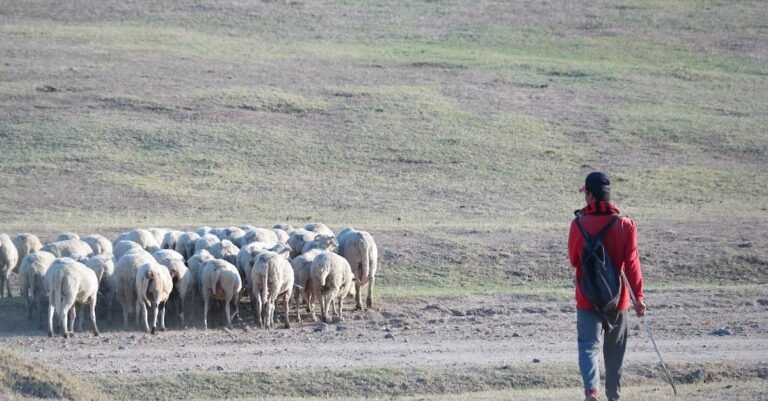Mastering Sheep Handling: Essential Equipment and Techniques for Catching Sheep Safely
Ever wondered how to catch a sheep? I’ll let you in on the secrets. With years of experience under my belt, I’ve mastered the art of sheep catching. It’s not as daunting as it may sound!
Sheep are known for their skittish and elusive nature. But don’t let that deter you. With the right approach and a little patience, you’ll be rounding up these woolly creatures in no time. Stay tuned as I guide you through the process.
Key Takeaways
- Understanding Sheep Behavior: Sheep instinctually follow flock mentality and have specific flight zones. Recognizing these patterns and the sheep’s body language is crucial in successfully capturing them.
- Building Trust: To catch a sheep, patience and consistent effort in building trust are needed. Practical ways include respecting its space, feeding it, and using a gentle tone of voice.
- Right Timing and Location: Observing daily routines and choosing a comfortable location is important. The best time is typically late morning to early afternoon in a quiet grazing area.
- Employing Effective Techniques: Clear and gentle communication, understanding sheep concerns, and utilizing trained sheepdogs can aid in easier sheep handling.
- Using Proper Equipment and Facilities: Employing network structures like pens and gates and utilizing sheep handling tools like a crook or a handheld sheep handler can facilitate easy movement and safety.
Understanding the Behavior of Sheep
In the world of sheep chasing, it’s crucial to comprehend the behavior of these woolly creatures. Sheep are herd animals and have inherent instincts that guide their behavior. Understanding these instinctual patterns will significantly improve our chances of successful capture.
First, let’s shine a light on the Flock Mentality. Sheep naturally gravitate towards their own kind; it’s in their nature to stick together. This instinct offers them safety in numbers when predators approach. Ever observed a sudden sprint in a seemingly peaceful flock? Chances are those sheep sensed danger and moved collectively for protection. If you aim to catch a sheep, this pattern will guide you in predicting their movements.
Next, consider their Flight Zone. The flight zone of a sheep is the area surrounding it that will cause it to flee once invaded. Typically, the size of this zone can vary based on the sheep’s personal experiences and its familiarity with humans. With a well-planned approach and controlled movement, you can use this zone to your advantage to guide the sheep where you want it to go.
Then there’s Field Vision: sheep have excellent peripheral vision due to their wide-set eyes. They can see almost 360-degrees around them without having to turn their head. But this comes with a trade-off. Their ability to judge depth or recognize details upfront is limited. Keep this in mind and try to approach from a direction that doesn’t startle them.
Let’s not forget about Sheep Communication. Did you know that they communicate using body language? A keen eye can interpret signs of discomfort or alarm in a sheep’s behavior. For example, a raised head and tense body can signal that a sheep has noticed something unusual.
Whether you’re a farmer, a hobbyist, or simply someone looking for a unique challenge, understanding the behavior of sheep is the first step towards becoming a successful sheep catcher. Stay tuned as we delve deeper into the techniques of catching sheep in the coming sections.
Building Trust with the Sheep
Understanding sheep behavior and instincts is crucial, but it’s not enough to successfully catch a sheep. Building trust with the sheep plays a fundamental role as well. Now, I’ll share some insights on how to establish such trust.
Sheep are timid by nature. They don’t trust easily — especially not humans who they perceive as predators. To build trust, you need patience and persistent effort. Start by spending time around your sheep, studiously avoiding any sudden or aggressive movements. Sheep, like many animals, are capable of recognizing humans and interpreting their actions, so show them you mean no harm.
The key here is to respect their space. Do not invade their flight zone unless absolutely necessary. A good practice is to sit or stand at a distance, just on the edge of this zone. Over time, they’ll get used to your presence.
When it’s feeding time, be the one to provide. Hold the feed bucket yourself and let the sheep come to you. This simple act, done consistently, associates your presence with something positive — food, in this case. However, ensure that you respect their comfort zone during these feeds.
Remember, trust is a two-way street. While you’re teaching them to trust you, you should also learn to trust their instincts. Understand the subtle signs of their body language. Sheep communicate their comfort and discomfort through shifts in their behavior. Acknowledge these signs and adjust your actions accordingly.
Lastly, speak softly. Voice tones can significantly impact how animals perceive humans. Choosing a gentle and calming tone will reassure the sheep. Over time, they’ll associate your voice with safety and your presence won’t induce fear or stress anymore.
Building trust with a sheep isn’t something that happens overnight. It’s a long process that needs patience, understanding, and consistent effort. Only through working on it daily, can you build a strong bond of trust with your sheep. As you grow in understanding and the bond deepens, catching a sheep won’t feel like a task anymore. Stay tuned as we proceed towards exploring other aspects of catching sheep.
Choosing the Right Time and Place
Now that we’ve established the importance of building trust with our wooly friends, let’s dive into figuring out the best time and place to make your move. Selecting the most suitable moment and location won’t only make the task easier, it’ll also help maintain the trust that you’ve worked so tirelessly to build.
Your first step here is to observe your sheep’s daily routines. Just like us humans, these gentle creatures are creatures of habit. They have preferred grazing areas and times for rest. Aim for a time when they’re in a comfortable location, typically grazing. Avoid disturbing their periods of rest. Late morning to early afternoon often works well.
However, be adaptable. Every herd is different, each with its unique rhythm. What works for one may not necessarily work for another. Keep tabs on your herd’s pattern and fine-tune your timing accordingly.
As for choosing a location, aim for areas where your sheep feel secure. Environments with fewer distractions and potential threats tend to lull the herd into a sense of safety. Of course, you need to ensure that you can carry out the task with ease in these areas. An ideal location would be a quiet, familiar grazing area — such as a pasture or meadow — away from busy roads or loud noises.
Make your move with confidence yet care, removing any sharp objects or potentially harmful obstacles from the area beforehand. Always remember, your actions should reflect respect for your sheep’s comfort and wellbeing.
By following these guidelines, you’re well on your way to effectively catching sheep, all while preserving the trust and bond you’ve created. As always, patience and persistence are key.
Employing Effective Sheep-Handling Techniques
After understanding the perfect time and location to catch our wooly friends, let’s delve into useful techniques that can help in sheep-handling. Remember, it’s not about dominating the sheep – it’s about partnership and trust.
Effective Communication can’t be overemphasized. Sheep are social animals and respond positively to clear, gentle commands. Using visual cues such as gesturing, along with verbal commands, engrains a sense of obedience and cooperation in them. However, excessive shouting can instill fear among sheep which might not be helpful in long-term bonding. Real mastery lies in negotiating with sheep using subtle, ‘sheep-friendly’ language.
Understanding Sheep Concerns is key to make them comfortable. Sheep have a keen sense of hearing and smell, but poor eyesight. They generally avoid suspicious objects and people, unfamiliar smells, and loud noises. Apprehensive about being cornered, they seek escape routes and maintain a good distance from possible threats. Getting acquainted with such quirks can make the sheep-catching process easier.
Let’s see a comparison of sheep sense in the following markdown table:
| Sense | Sheep Sensitivity |
|---|---|
| Sight | Poor |
| Hearing | High |
| Smell | High |
Another effective technique is Herding Using Dogs. Sheepdogs, when trained properly, are excellent allies in herding. They are employed to maneuver the flock in a specific direction. But it’s crucial to ensure the dogs don’t scare or harass the sheep. A proficient sheepdog communicates calmly and confidently with the sheep, persuading them to move in a desired direction.
Indeed, guidance on handling sheep does not end here. By going deeper into the principles of good handling, we can channel the natural instincts of sheep to their advantage. Shortly, we’ll delve further into an interesting aspect of sheep psychology which improves our methods.
Utilizing Proper Equipment and Facilities
Now that we have understood the basics about sheep behavior and how to communicate effectively with them, let’s delve deeper into the practical aspects. The right facilities and equipment play an integral role in managing sheep effectively.
Sheep Handling Systems are a crucial part of everyday tasks. Structured network of pens, gates, and alleys permit easy movement of sheep around the farm. They are designed to lessen stress associated with handling, while ensuring safety for both the handler and the sheep.
On the subject of physical contact with our woolly friends, we come across Sheep Catching Devices. Using the appropriate type of catching device can make your job easier, mitigating potential injuries for both the sheep and yourself. Depending on the work at hand, the catching devices vary from crooks to handheld sheep handlers.
Let’s take a quick peek at some handlers:
- Crook: Traditional style tool designed with a curved hook to catch a sheep’s neck gently.
- Handheld Sheep Handler: A compact and portable device designed for close-range handling.
These tools are used primarily for catching and controlling the sheep, reducing strain on the handler and stress to the animal.
Speaking of stress, Sheep Shearing Equipment warrants a mention too. Shearing can be a stressful practice for these animals. It requires the right balance of tactics, equipment and skills to ensure it is a comfortable, safe experience for the sheep. Electric clippers, hand shears, and blowers are commonly used. Shearing must always be performed by trained, experienced shearers.
These are just a few aspects of sheep handling equipment. Other aspects, like the feeders, waterers, and housing facilities, also play a crucial role in sheep management. Remember, your equipment setup may be unique, depending on your farm’s size, layout, and the number of sheep. Choosing and using the right equipment can make your daily routine with sheep smoother and safer. As always, the wellbeing of the sheep is paramount.
Conclusion
So, there you have it. We’ve delved deep into the world of sheep handling, shedding light on the critical role of equipment and facilities. We’ve seen how pens, gates, and alleys can make the process stress-free and safe for both you and your sheep. We’ve explored the effectiveness of catching devices like crooks and handheld sheep handlers. We’ve underscored the significance of skilled shearers and right shearing equipment. Lastly, we’ve touched upon how feeders, waterers, and housing facilities contribute to overall sheep management. It’s clear that catching a sheep isn’t just about the act itself, but about creating an environment that prioritizes the welfare of the sheep and the efficiency of the handler. With the right knowledge and tools, you’re well on your way to mastering the art of sheep catching.







